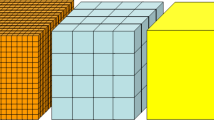Abstract
This paper considers a high-contrast, two-component composite of random structure, for whose simulation a two-dimensional network model is used. The dependence of the medium conductance on the volume content and composition of the filler that is characteristic of percolation theory has been obtained: up to some volume content, the effective conductance is small and then it grows rapidly. The results are based on statistical modeling (solving a large number of problems at various random distributions of inclusions and with subsequent statistical processing).
Similar content being viewed by others
References
H. Kuchling, Physik [Russian translation], Mir, Moscow (1982).
S. M. Kozlov, Averaging of random operators, Mat. Sb., 109, No. 2, 188–203 (1979).
G. Papanicolaou and S. Varadhan, Boundary-value problems with rapidly oscillating random coefficients, in: Random Fields, North-Holland, Amsterdam (1981), pp. 835–873.
J. B. Keller, Conductivity of a medium containing a dense array of perfectly conducting spheres or cylinders or nonconducting cylinders, J. Appl. Phys., 34, No. 4, 991–993 (1963).
A. M. Dykhne, Conductivity of a two-dimensional, two-phase system, Zh. Éksp. Teor. Fiz., 1070, No. 7, 110–116 (1970).
W. F. Brown, Dielectrics [Russian translation], Mir, Moscow (1970).
A. G. Kolpakov, Finite-dimensional model of conductivity of densely packed particles, Zh. Vych. Mat. Mat. Fiz., 43, No. 1, 133–148 (2003).
L. Borcea and G. Papanicolaou, Network approximation for transport properties of high contrast materials, SIAM J. Appl. Math., 58, No. 2, 501–539 (1998).
G. Grimmett, Percolation, Springer-Verlag, Berlin-Heidelberg-New York (1989).
J.-L. Lions, Notes on some computational aspects of the method of homogenization in composite materials, in: Computational Methods in Mathematics, Geophysics, and Optimum Control [in Russian], Nauka, Novosibirsk (1978), pp. 5–19.
W. R. Smythe, Static and Dynamic Electricity [Russian translation], IL, Moscow (1954).
H. Kesten, Percolation Theory for Mathematicians [Russian translation], Mir, Moscow (1986).
Author information
Authors and Affiliations
Additional information
__________
Translated from Inzhenerno-Fizicheskii Zhurnal, Vol. 78, No. 6, pp. 170–177, November–December, 2005.
Rights and permissions
About this article
Cite this article
Kolpakov, A.G. Effective conductance of a high-contrast, random-structure composite. Numerical simulation. J Eng Phys Thermophys 78, 1222–1230 (2005). https://doi.org/10.1007/s10891-006-0056-7
Received:
Revised:
Issue Date:
DOI: https://doi.org/10.1007/s10891-006-0056-7




